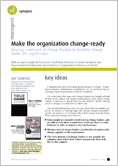True Change

An original change approach, that contradicts the idea that executives are primarily responsible for leading change.
Author(s): Janice A. Klein
Publisher: Jossey-Bass
Date of publication: 2004
Manageris opinion
This book proposes an original change approach, by contradicting the idea that executives are primarily responsible for leading change. The author’s premise is that change is doomed to failure if it is dictated from the top and then imposed on the rest of the organization. Indeed, “real change” means changing the company culture deep down. Otherwise, people will initially apply the new directives, but gradually fall back to their old habits over time. To avoid this, the author recommends that companies organize themselves to drive change from the inside, using a network of internal change agents.
– The first part of the book, chapters 2 to 4, analyzes the challenges encountered by many companies when they initiate a major transformation. Using detailed examples, including that of a manufacturing company that tried to introduce lean management, the author gradually introduces the concepts underpinning the rest of the book, namely, that change is more effective if it is supported by the employees who are expected to apply it, if it takes account of the existing culture, and if it is designed and implemented at the operational level. The core of the book is chapter 2, which presents the “outsider/insider” concept. Some individuals are effectively able to assimilate the culture and operating practices of the company, while continuing to view accepted practices objectively, in order to propose different solutions. The company can thus rely on these individuals to lead change truly “from the inside.” The rest of this section can be perused rapidly.
– The second part of the book offers many concrete tips on developing and capitalizing upon these ""outsiders/insiders.” How to train existing employees to adopt a more outside-in point of view (chapter 5)? How, on the other hand, to ensure that newcomers assimilate the company culture, while making sure that they do not lose their external perspective (chapter 6)? How to ensure that their initiatives are consistent with company strategy (chapter 7)? Finally, how to sustain their simultaneously critical and committed mindset toward the company (chapter 8)?

